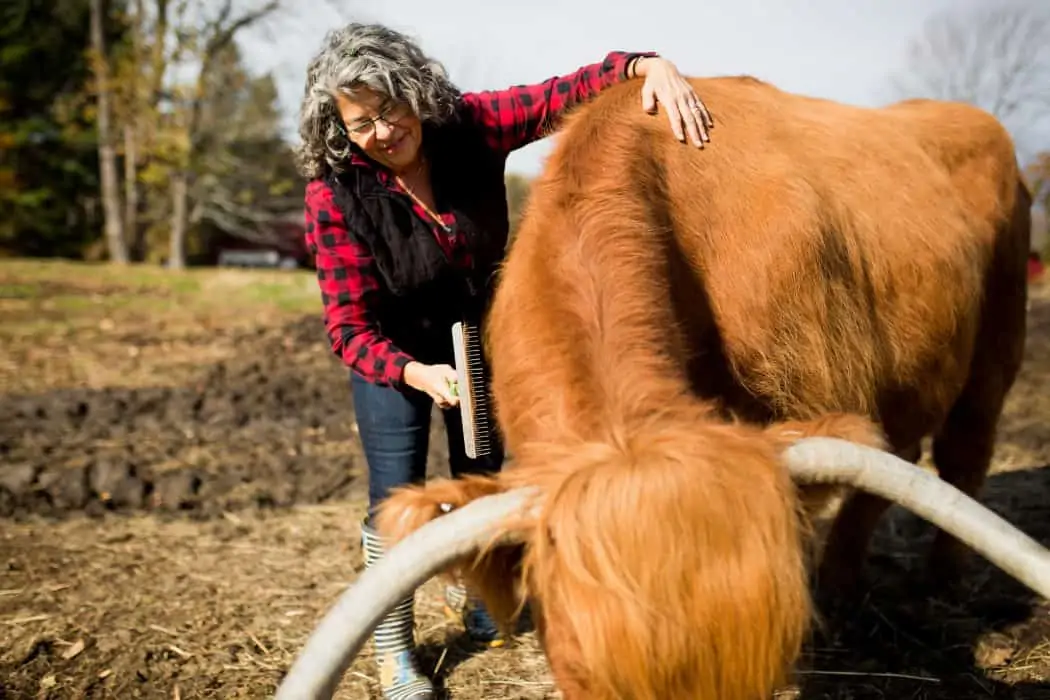Janet Seward did not have an average FarmHer journey. Growing up in New York, she was considered a flatlander. But after over 40 years in Vermont, she easily can call it and her Scottish Highland cattle home. What started with five head of cattle has grown into a full herd of 170 head, and preserves the oldest registered Highland cattle genetics.
The Beautiful View of Highland Cattle On Top of the Farm
I arrived in Plainfield, Vermont on a crisp, autumn morning. The beauty of the Highland cattle complimented the fall colors perfectly. First, I met the most important people on the farm: the herd.

It was quite the sight to see Janet moving the cattle from one field to the next. As she says, it’s like being in charge of a first-grade class following the teacher. The cattle moseyed right behind her and found the perfect view from the top of their farm.
Highland Cattle Beef Is One of a Kind
Besides their gorgeous, orange colored hair, Highland cattle also produce one of a kind beef.
If you have never tried Highland beef before, you are not alone. One unique aspect of Highland cattle is their thick, heavy coats. Traditional beef cattle must put on a layer of fat in order to insulate themselves. With Highland beef, the marbling goes directly into the muscle thanks to their coat of hair.

They also are the only breed of beef that will marble to 100% purely on grass for feed.
Janet and her husband Ray started their business, Greenfield Highland Beef, around 15 years ago. At first, they sold their beef at farmers’ markets. Now, they sell to a large customer base with a majority of their customers within 40 miles of where the beef was raised.
In beginning, they gave out tons of samples because they truly believe in the difference in taste and marbling of Highland cattle beef. After trying it, so do their customers.
Time For Some Pampering
After we moved and discussed the cattle, it was time for some love and care. Highland cattle are known to be a very docile breed and Janet also shows some of her herd. Because of these two factors, many of her cattle love to be groomed and pampered regularly.

We pulled out brushes, and went to work. And the cattle absolutely loved it, especially under the chin in their special spot.
The Good Life in Vermont
The good life is something you feel when you step onto Janet’s farm. She’s found peace with the animals she once feared. Now, they are more than a herd, they are members of her family.



Beautiful cattle! I bet grooming them is wonderful for the groomed and the groomer! ?
Awesome therapy! If you are having a bad day, comb a cow and the world seems like a better place!
Do you have a link to watch and share your program?
FarmHer airs on RFD-TV on Fridays and Sundays at 8:30 pm CT.
I’m glad you’re following your dream. I grew up farming it’s a good life. I’ve been away from it for 30 years. I’d love to get back to it some day. On your Scottish Highlander cattle here in Nebraska they seem to treat them like pets for some reason. I’m ok with that. When I was a kid I had 40 bucket calves and I wanted to keep em. But I guess what I’m asking do Scottish Highlander bulls cross well with Angus cows. I don’t want to pull calves. And I like a cross need replacement hefeir. Thanks and take care.
We cross our Highlands with Beef Shorthorns and have no problem with calving. Highland calves are smaller than most breeds.
i liked the article it told me that she lived in new york and after time wile she lived in vernmont she started to grow caltle and she has alot and she was suseful
I’m trying to purchase one don’t know where to look